Jordan may not have been on my top ten list for countries I wanted to visit but this is truly one of the gems of the Middle East. Long wanting to visit Petra, the ancient Nabatean city made famous to Westerners in Indiana Jones and the Last Crusade, it was somewhat on my radar as a place to visit. However, outside of the famous landmark building called the Treasury in Petra, my knowledge of this country was little to none. So when I received an invitation to join some fellow colleagues in the adventure travel space at a conference in Amman, Jordan’s capital, I jumped at the chance to learn more about this Middle Eastern country nestled right in the heart of the Arab world. Let me start off by saying that Jordan is UNIQUE. It is home to the lowest place on Earth; one of the 7 wonders of the world, Petra; the birthplace of Christianity; one of the largest ancient Roman cities in the world; and has a vast diversity in landscapes, history, and culture – plus a surprising and growing variety of activities catered to active adventurers.
Needless to say, there is much to be discovered and explored here! So much so that I recommend dedicating at least two weeks to this incredible destination if you plan to visit it for yourself. This should provide you with ample time to experience some of Jordan’s greatest attractions and highlights.
17 Unforgettable Things to Do in Jordan
Here are some of the best things to do and see in Jordan during a 2-week trip!
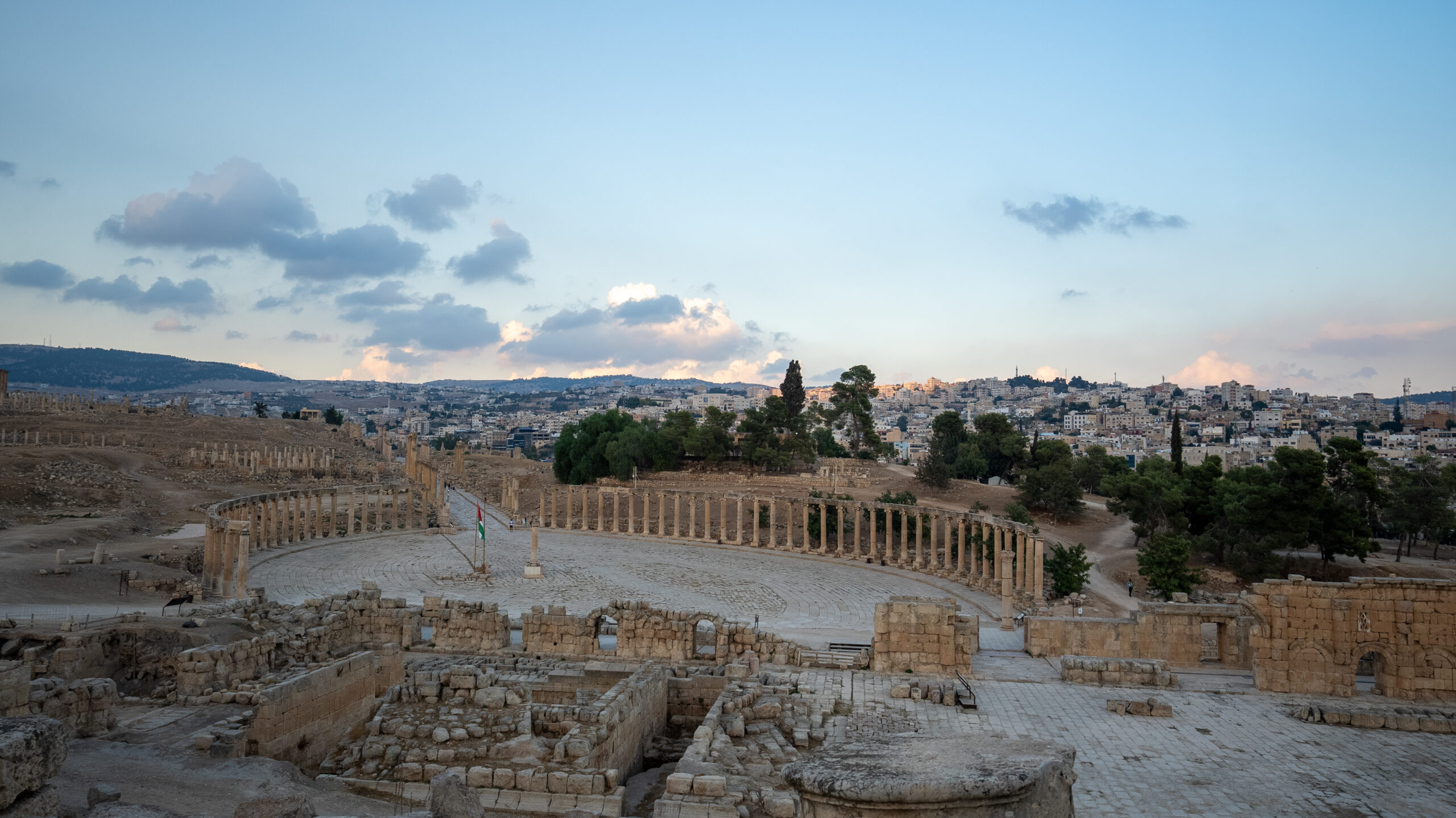
Visit Amman
Spend a few days in Amman, where you can immerse yourself in history, food, and culture. With most international flights starting and ending in the city, you will likely need to stay at least a night. And while there, you’ll find plenty of things to keep you busy in this vibrant metropolis.
I spent 5 nights in Amman. Check out this Video to See More
Visit the Amman Citadel & Roman Amphitheater
History buffs will first want to visit the Amman Citadel, located high on a hill in the center of Amman. The Amman Citadel is a remnant of the ancient capital of Philadelphia, one of the ten great Roman cities of the Decapolis era. Amman has had several names in its thousands of years of history, many of which tie into the rulers of the land at the time.
The Citadel is home to ancient architectural landmarks, including the temple of Hercules, which was built by Roman rulers, as well as the skeleton of an old castle built by the Umayyad Arabs. There is also a museum where many ancient Roman, Omayad, and Byzantine artifacts can be seen. This makes a great first stop for any visit to Amman.
When you’re done here, be sure to take a short ride down to the Roman Amphitheater. This is the oldest and most fully intact piece of architecture from Roman rule left in Amman.
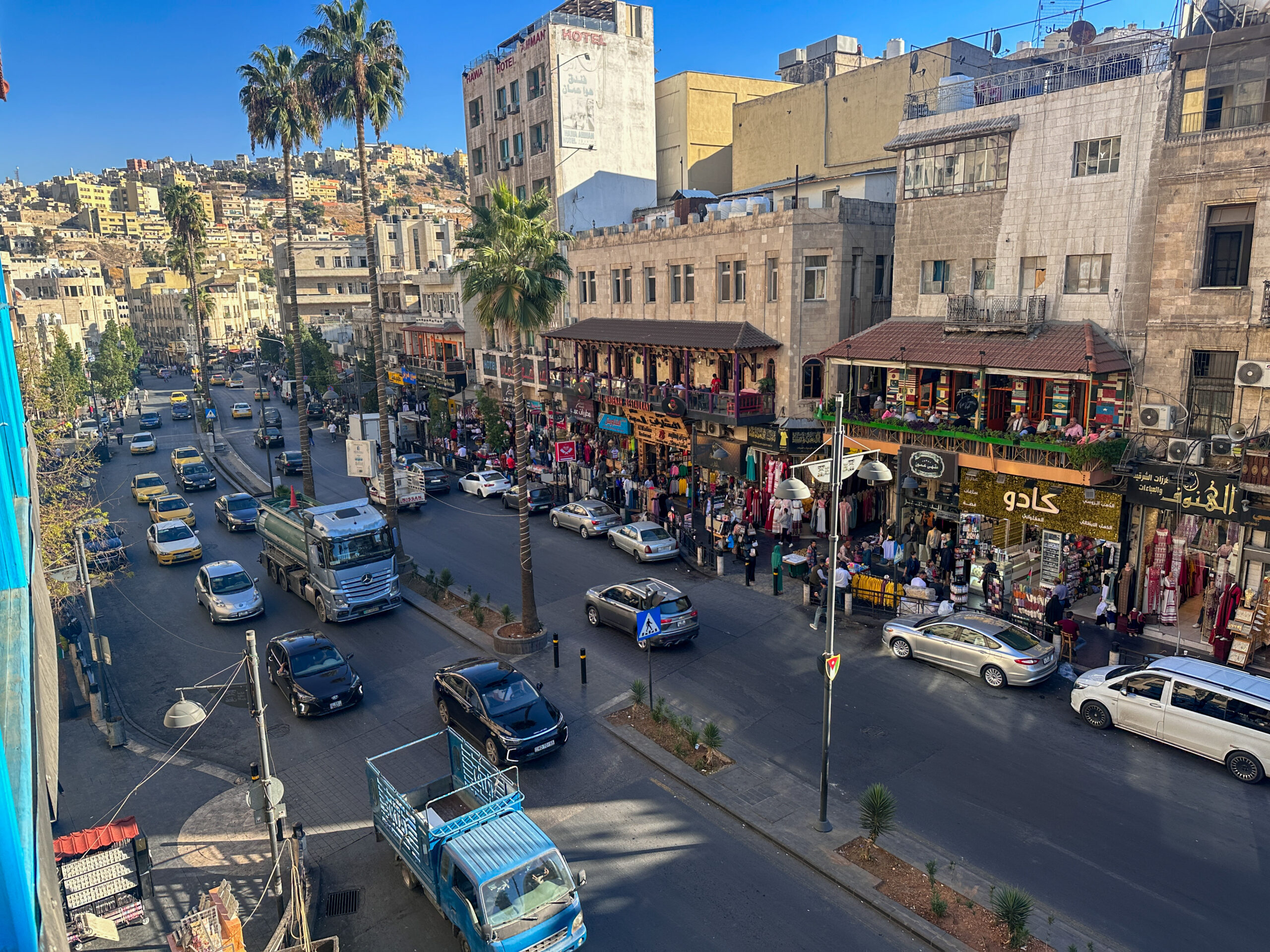
Eat & Shop Your Heart Out
The Roman Amphitheater also happens to be located in an excellent area of town and is within walking distance of many great shops and restaurants. Some places not to be missed include Rainbow Street, Santee Alley, and the numerous sweet shops that sell Nafee.
While you’re here, be sure to visit an upstairs cafe for a great view of the street below. At these establishments, you can typically try hookah and order one of the city’s great fizzy fruit juices.
For cocktails, head into a hotel or fancier restaurant in the more touristy areas. Alcohol is not served in most establishments as this is primarily a Muslim country but most hotels catered to foreigners have fantastic alcohol selections.
Finally, don’t leave without grabbing a shawarma at Reem – even the locals stand in this queue, which is located just down the street from the Intercontinental Amman.
Check Out the Souks
Amman is home to several Souks or local markets, where you’ll find a variety of handmade goods, including jewelry, pottery, rugs, and spices. While the city’s traditional souk is only open on Saturdays, other markets spread throughout Amman sell goods all week long. One of the most popular is the Gold Souk, which is known for its incredible gold and silver jewelry.
Visit the Blue Mosque
The Blue Mosque, officially known as the King Abdullah I Mosque, was built in 1989 by the late King Hussein as a memorial to his grandfather, the first king of Jordan. Renowned for its stunning blue dome and mosaic patterning, this active house of worship is the only mosque in Amman open to non-Muslim visitors. Find Tickets and Tours of Amman
Inside, the structure houses a large prayer hall, a spacious courtyard, a royal enclosure, and a small museum, where you’ll find Islamic artifacts and personal belongings of King Abdullah I. Please note that in order to enter the mosque, women are required to dress modestly and must cover their hair. Headscarves and full-length dresses are available at the entrance to the mosque if needed.

Take a Cooking Class at Biett Sitti
Run by a local Jordanian family, Biett Sitti offers private and group cooking classes, while also empowering local woman. Here, you’ll have the opportunity to learn how to cook a four-course meal, complete with an entree, salad, side dish, and dessert. While specific dishes may vary, previous classes have included musakhan (roasted chicken with pine nuts), fattet magdoos (pita bread with eggplant), and mansaf (lamb with yogurt and rice). This was one of my favorite experiences in Amman, and a delicious one as well. Watch the video below for more details.
Spend a Day Walking the Ancient Streets of Jerash
Jerash is the largest and most well-preserved ancient Roman city outside Rome. Located just over an hour from Amman, it’s a must-visit when coming to Jordan. The city is vast and will take you well over an hour to walk from end to end. Within it, you can find two Roman amphitheaters, very well-intact stretches of ancient roadway, historic entrance gates, a colonnaded city center, and the ruins of several ancient buildings. Look closely, and you will see Roman letters on many of the old stones as well. There is even an old arena where roman chariot races and gladiator matches once took place.
Want a tour guide to explore this ancient city: You might like the: Full-Day Tour of Umm Qais, Jerash, and Ajloun from Amman

Take a Walk through Christian History in Madaba
Madaba is known as the Mosaic city, and as I strolled through the ancient streets, I could certainly feel the echoes of centuries past. Madaba has several churches and archeological sites with Byzantine and Umayyad mosaics. The most well-known is a large Byzantine mosaic map of the Holy Land still in-lain on the floor of a church. The map was discovered in 1896 and depicts the Holy Land from the 6th century. Other uncovered parts of the city have also revealed Byzantine mosaics covering the floors and walls of several structures dating back to the city’s earliest period of habitation. It’s a truly unique place to explore, especially for the ancient history of both humankind and religion.

Mosaic floor of the olive tree in Madaba
Grab a Bite to Eat at Carob House
A must is a meal at one of the best restaurants in Jordan, Carob House in Madaba. This establishment promotes regenerative agriculture and is 100% farm-to-fork. A changing seasonal menu often features hummus, tabouleh, roasted vegetables, falafel, and shawarma. This was hands down one of the best meals I had in Jordan.
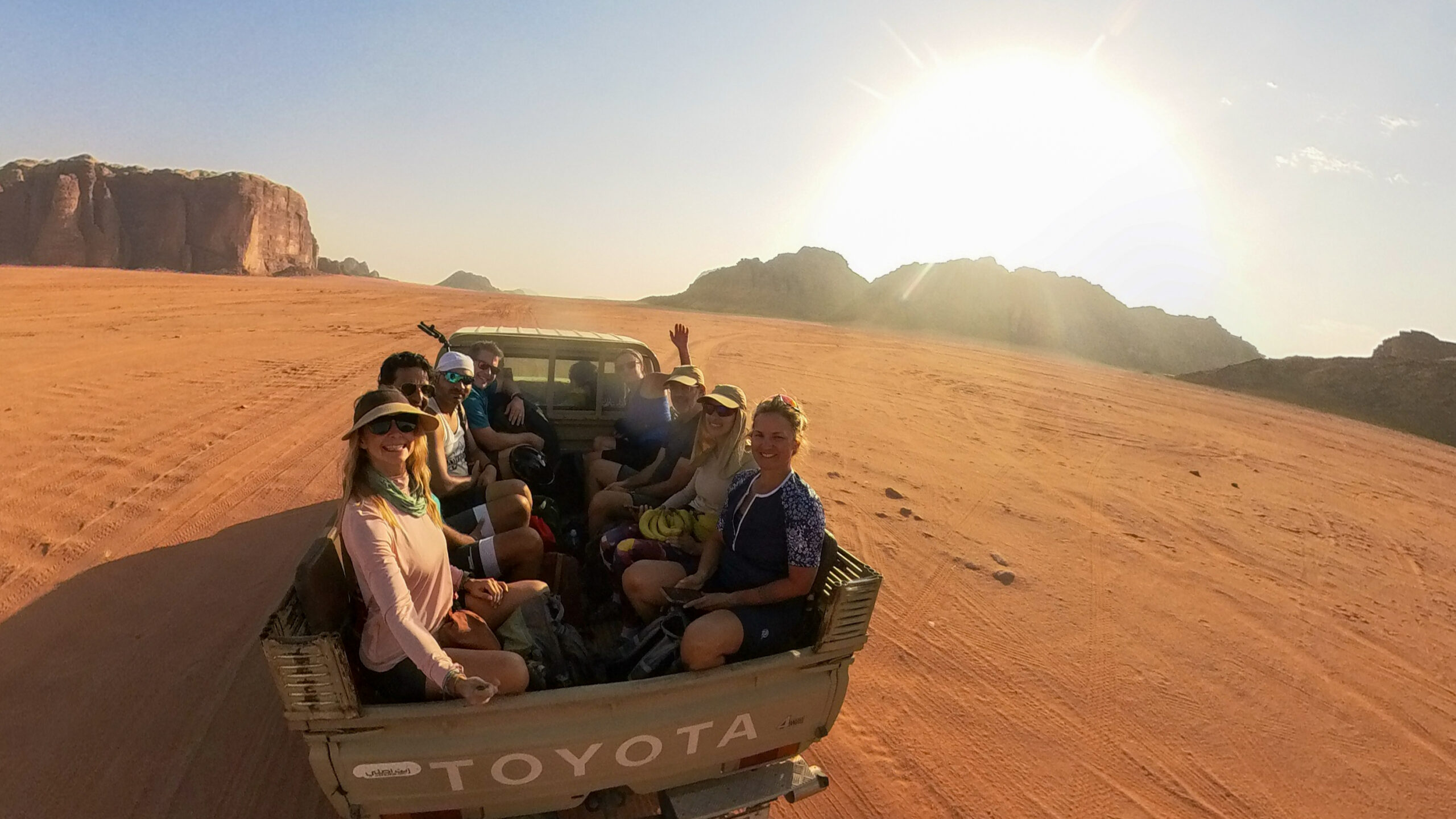
Spend 8 Days on an Adventure Tour With Terhaal Adventures
If you’re not sure how to get around and how to travel in Jordan or simply prefer a guided experience, consider booking a tour with Terhaal Adventures. As a Jordanian tour operator, Terhaal partners with local communities to offer a variety of responsible adventure tours. These tours typically feature a mix of activities, including hiking, biking, canyoning, trekking, and sightseeing.
While Terhaal offers countless experiences for you to choose from, their Jordan Adventure Tour is an excellent option if you wish to visit the country’s highlights. On this tour, you’ll have the opportunity to hike in the Dana Nature Reserve, discover the sand dunes of Wadi Rum, float in the Dead Sea, explore off-the-beaten-path in Petra, and spend a night in the desert at a local Bedouin campsite.
I spent 5 days hiking, biking and traversing the countryside and had the absolute best time. Some of the highlights of my experience were camping in the desert in Little Petra, staying in the Wadi Rum with the Bedouins and spending the day in Petra. The full experience can be seen in this video: I hiked to one of the 7 wonders of the World.
Hike or Bike Part of the Jordan Trail
For bikers and backpackers, Jordan offers some unique and well-catered trails. The longest of these is the Jordan Trail, which runs from the olive grove-covered north and travels 400 miles south through the Dana Biosphere Reserve, into Petra, through the Wadi Rum Desert, and ends in Aqaba by the Red Sea. To do the trail in full takes a whopping 42 days. Or alternatively, you can explore a few of its most popular sections, which include hiking into Petra and biking through the Wadi Rum Desert. Hikers and bikers can choose to do this trail fully or partially supported depending on your travel style. Many local companies can set up food supplies, lodging and logistics for your multiple day journey through the country.
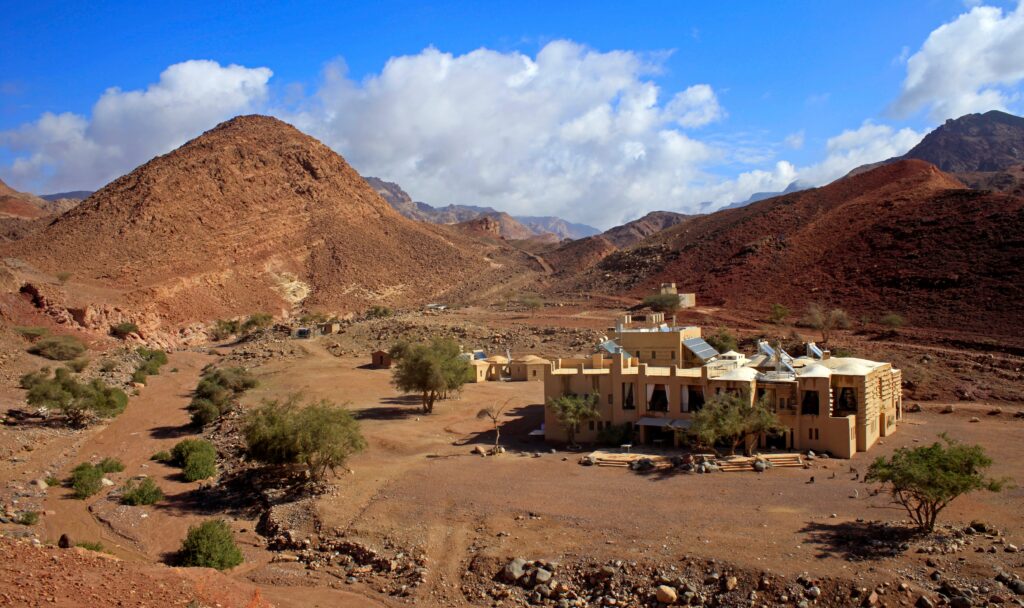
Feynan Ecolodge and Wadi Dana Beyond © Feynan Ecolodge
Another excellent option for a first hike in Jordan is the Dana Biosphere Reserve. Covering more than 300 square kilometers of spectacular mountains and Wadis along the face of the Great Rift Valley, Dana Biosphere Reserve is Jordan’s largest nature reserve. It also happens to be home to an impressive variety of plants and wildlife (including Ibex or wild goats) and features brightly colored and uniquely shaped sandstone characteristics that resemble the deserts of the southwest US. For those traveling through this section of the trail one of the highlights for many is staying at the Feynan Ecolodge in the heart of the Reserve. Hailed as one of the worlds best eco-lodges it runs on solar power and offers one of the best eco experiences in all of Jordan.
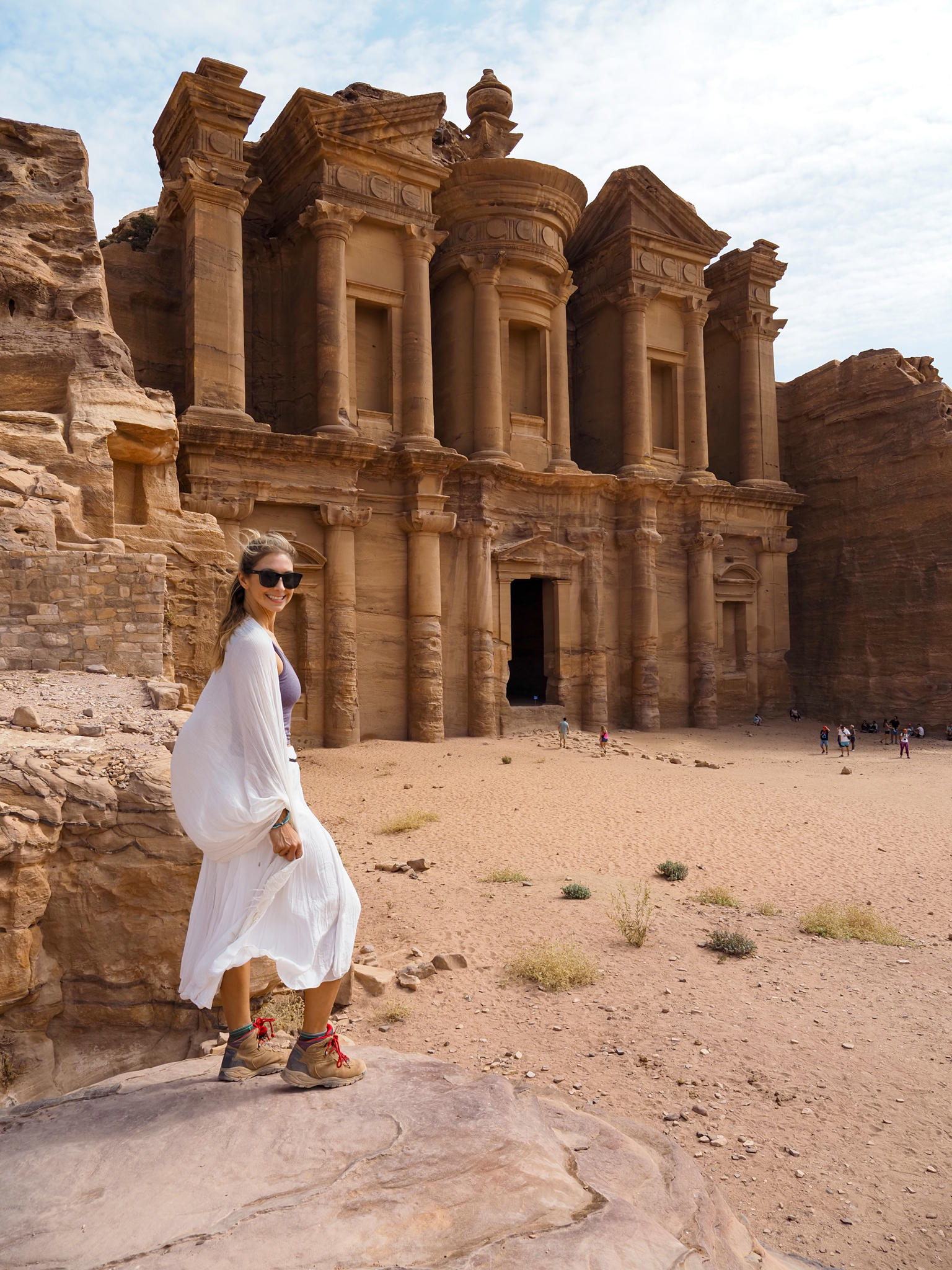
Explore the Ancient City of Petra via the Back Door Trail
The Back Door Trail is the less-traveled entrance into the ancient city of Petra. Departing from the area of Little Petra, it traverses the canyon walls up a series of stairs and ridges for several kilometers before entering the city of Petra. Along this section of the trail, I passed expansive views of the desert valleys beyond and soon enough started to see ancient tombs and cisterns from centuries past. And then, as I rounded a final bend, a colossal structure appeared carved into the rock: the Monastery.
Since I had entered through the Back Door Trail, I would be walking the city in reverse, and it was way bigger than I expected, taking me another 6 hours to walk from the Monastery through to the main entrance where most tourists entered. From this part of the city, I followed a series of stairs and pathways carved into the sandstone that pass through tourist shops and tea houses that border the trail’s edges. Every now and then, a donkey or horse would come snorting up or down the path carrying an oversized human that had already tired of all the stairs. When the stairs ended, I was spit out into a vast open area that once held the city’s main buildings, and I’m sure they must have been magnificent in their peak. It’s hard to pick and choose which places to stop and gander at and which ones to miss, as there is just so much to see in this massive ancient city.

Hiking the back door trail into Petra
Established around the 1st century BCE by the Nabataeans, this ancient metropolis flourished as a crucial crossroads for trade routes. It was built in the heart of the Sharah Mountains and prospered in the centuries BC and AD, serving as a vital part of major trade routes between Mesopotamia and Egypt. Today, intricate facades sculpted into the sandstone cliffs can easily be admired, along with other remarkably well-preserved structures from this ancient city. It is a testament to the Nabataeans’ engineering prowess and architectural ingenuity. The buildings are designed with influence from Egypt, Rome, Greece, and Umayyad, a testament to the architects who wanted this city to welcome the many cultures passing through its streets.
In its heyday, Petra thrived as a bustling city strategically located for trade between the East and West. However, the city gradually declined with the shift of trade routes, and by the 7th century CE, it had fallen into relative obscurity. Today, Petra’s enduring allure lies in its well-preserved tombs, intricate facades, and the archaeological remnants of a once-vibrant civilization.
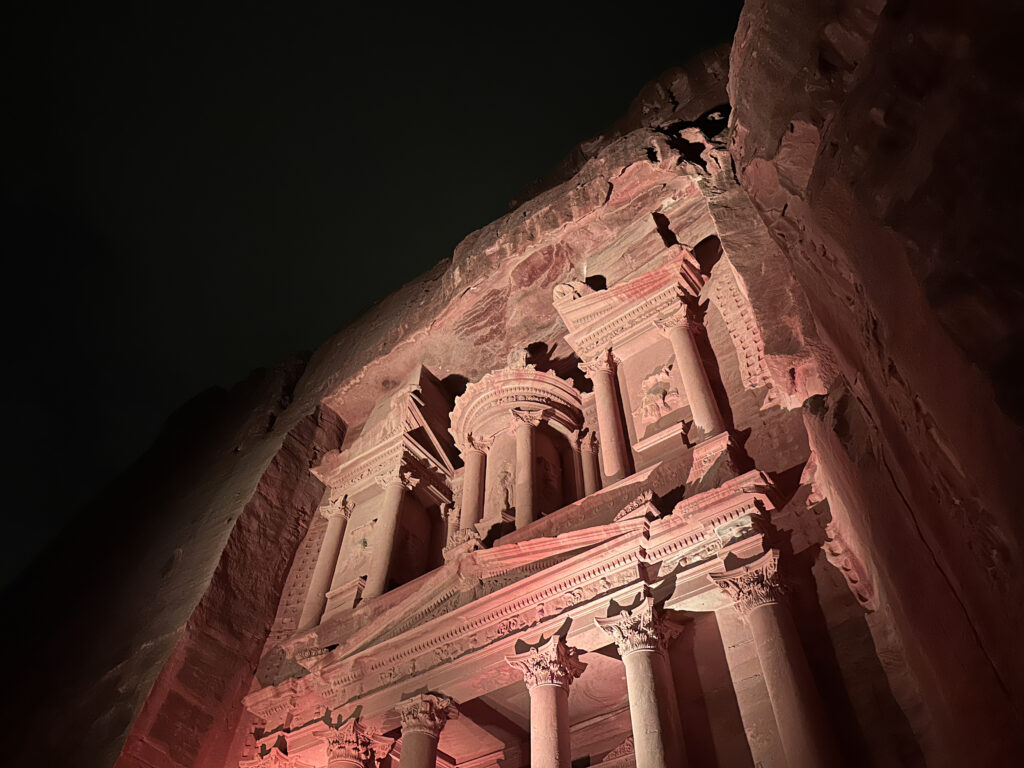
The Treasury at Night
At 6pm, the gates to Petra close, but a few days a week, it reopens at night for a special experience called Petra By Night. It was a long walk to get back down to the Treasury from the town of Wadi Musa. However, seeing the Treasury by candlelight was a truly unique experience.
For a real adventure that includes the Back Door Trail of Petra, be sure to check out this 7-day Hiking and Biking Tour of Madaba, Petra, and the Wadi Rum.
Visit the Baptism Site of Jesus & the Location Where Moses Saw the Holy Land
If exploring Jordan by car, which is extremely easy to do on its well-maintained roads, you’ll have the opportunity to visit two significant religious sites.
The first is the Baptism Site of Jesus, also known as Al-Maghtas or “Bethany beyond the Jordan.” Situated just north of the Dead Sea, along the eastern banks of the Jordan River, this archaeological World Heritage Site is believed to be the original location where Jesus was baptized by John the Baptist. Guided tours of the area are offered for those who wish to explore and include several notable attractions, including the actual baptism site, the Jordan River, and St. John the Baptist Church.
Located just 40 minutes southeast of the baptism site, you’ll find Mount Nebo, the location where Moses is believed to have seen the Holy Land. Here, you can visit the Moses Memorial Church, explore the La Storia Museum, and take in incredible views that extend all the way to Israel.
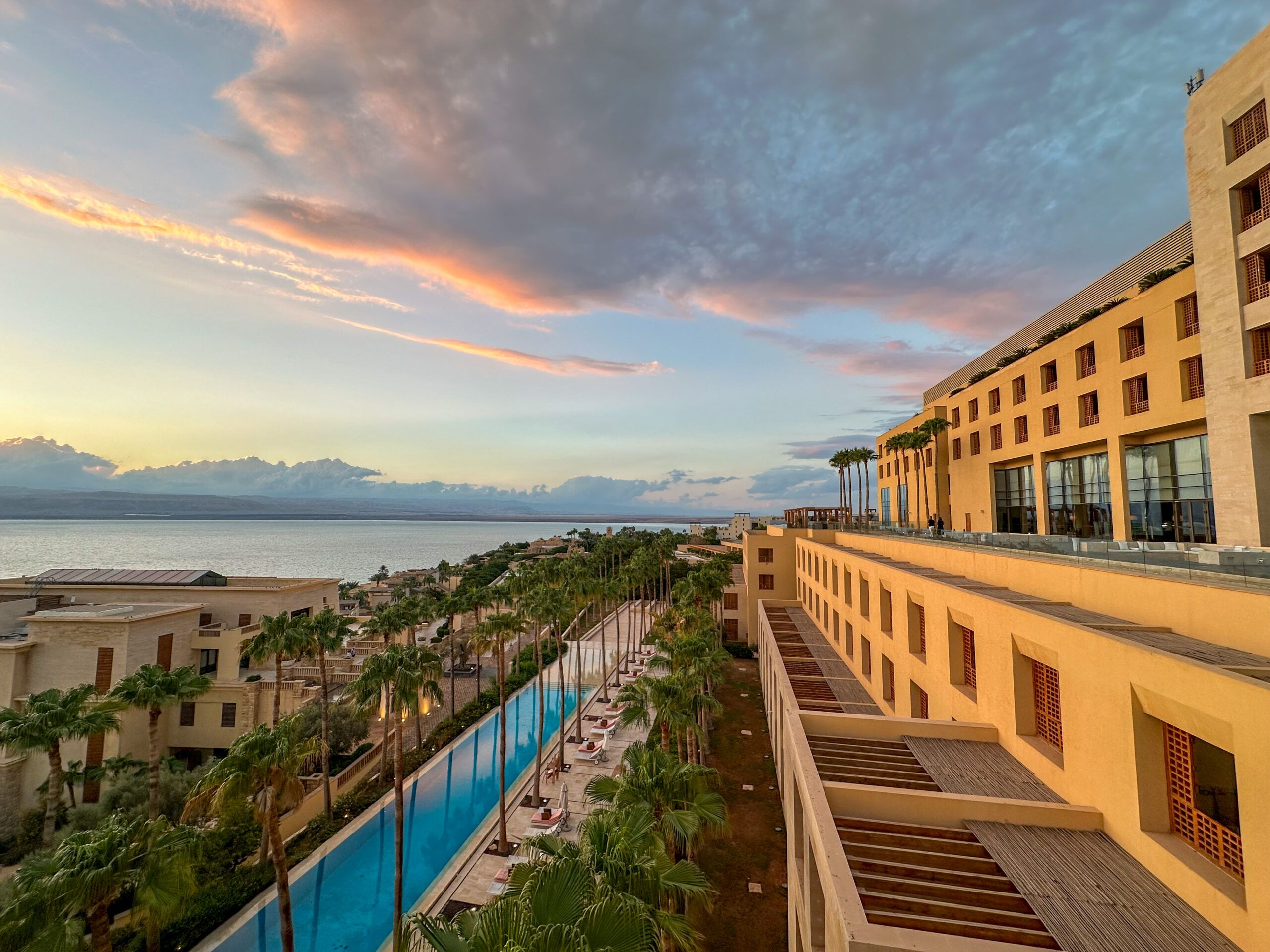
Relax at the Dead Sea
The lowest place on Earth also happens to be an inland salt lake known as the Dead Sea. Regarded around the world as one of the saltiest places on Earth, the Dead Sea is so salty that just about anyone can float on it, as its salt content is 3 times that of the ocean.
For the full-day spa experience here, it’s best to stay at a resort that lies right on the beach. I recommend Kempinski Hotel Ishtar Dead Sea, as it offers direct access to the Dead Sea, as well as a full-service spa.
If this isn’t an option, you can instead get a day pass to one of the Dead Sea’s beach resorts. These passes typically include beach access, mud, towels, and use of the property’s showers.
Alternatively, there is also a public beach, but as of my last visit, it was closed due to the emergence of sinkholes. It is unknown when or if the beach will reopen.
**A quick note: Beware of the flies while visiting the Dead Sea. They’re known to swarm the beaches during the warmer, more humid months.
Go Canyoning at Wadi Mujib
If you’ve heard of the Narrows in Utah’s Zion National Park, then this is an adventure you’re likely to enjoy. Wadi Mujib is located just south of the Dead Sea and offers water-loving adventurers a unique way to wander the narrow river-filled canyon of the Wadi Mujib. The river runs right through this slot canyon, emptying into the Dead Sea. It is one of just two freshwater rivers in Jordan and a favorite place for travelers to come and cool off on a hot desert day.
Grab a life jacket and water shoes at the entrance and spend a few hours walking up the river, climbing ladders through waterfalls, and marveling at the hundred-foot-tall walls that have been carved by a millennia of moving water. The canyon trail ends at a huge waterfall, where you will want to grab a few shots on your waterproof camera before lying down to float, swim, or wade back to the beginning of the trail. You can purchase tickets right at the entrance, which also comes with a life jacket and water shoes can be purchased for around $5 as well. Locker rooms are also available for changing and storing your belongings.
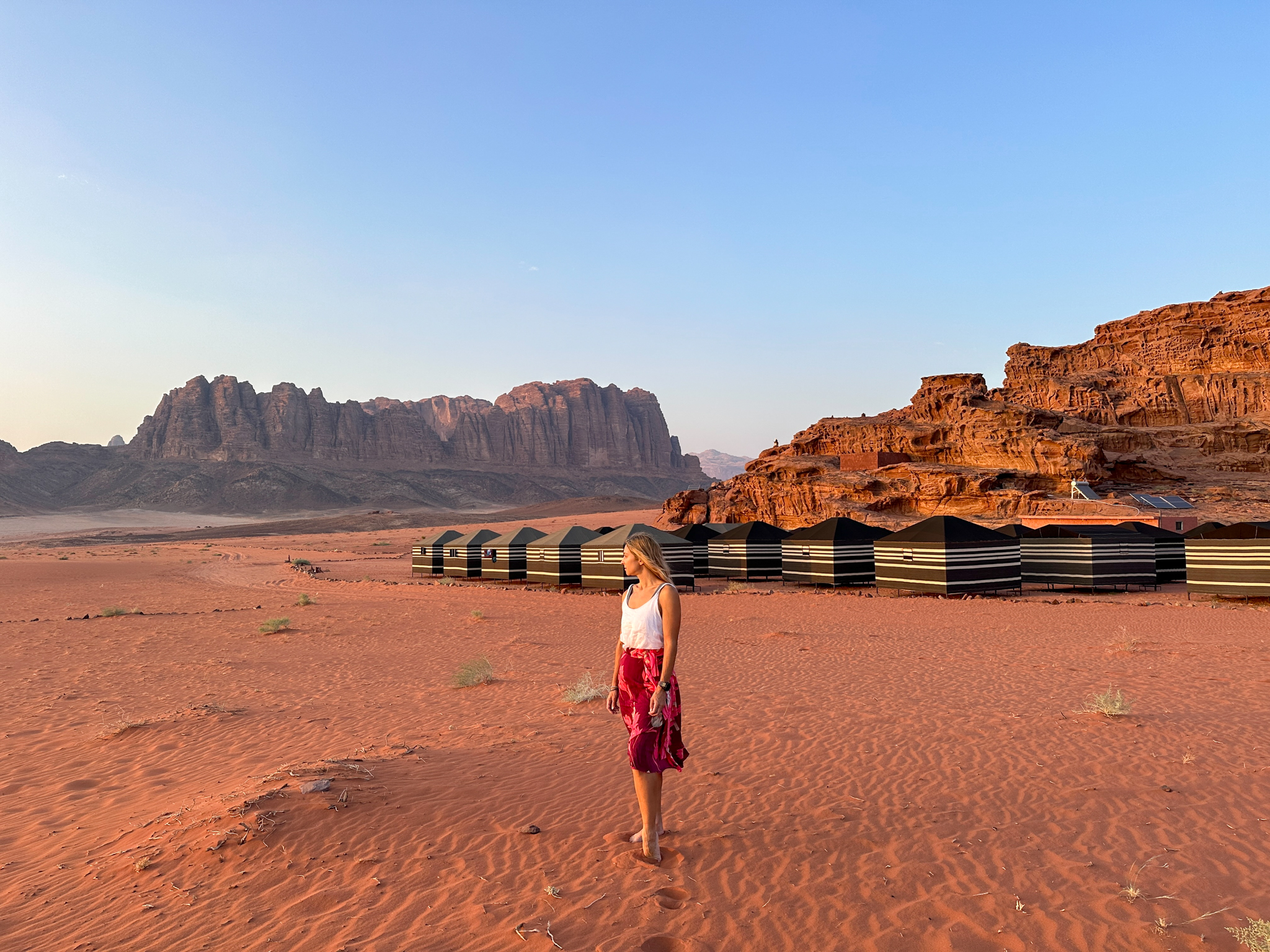
Explore the Wadi Rum Desert
Encompassing 74,000 hectares, the Wadi Rum Desert is a Unesco World Heritage site known for its striking red landscapes and otherworldly rock formations. It also happens to be a historically significant site, as it’s home to several archaeological sites, some dating as far back as 12,000 years. In fact, over 25,000 petroglyphs and 20,000 inscriptions have been found throughout Wadi Rum, depicting the vital role the desert has played throughout human history. And even today, groups of nomadic Bedouins continue to call the land home.
As a visitor to Wadi Rum, you can explore this spectacular landscape and witness its history up close and personal. Many of the desert’s historical sites, such as the Nabatean Temple and Anfeshiyeh Inscriptions, are open to the public. As are several natural destinations, including Khazali Canyon, Um Fruth Rock Bridge, and the sand dunes.
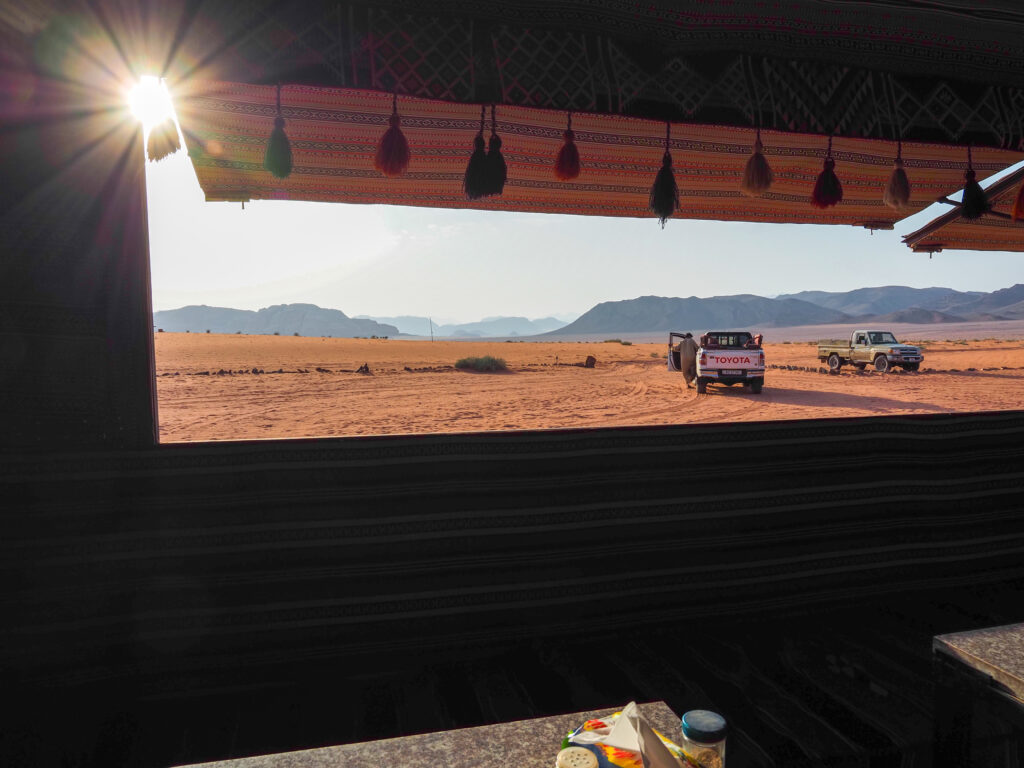
Views of the Wadi Rum from Sunrise Camp
That all being said, it’s best to explore the desert with a guide or on a tour. The desert is large, and it’s easy to get lost, so it’s always a good idea to err on caution, especially if it’s your first time visiting Wadi Rum. There are a number of tours that you can choose from, offering a variety of experiences, including hiking, rock climbing, horseback riding, and off-roading.
For the best experience stay at a local Bedouin Camp for at least one night, and let the host give you a tour of the desert. There are dozens of options when booking a place in the Wadi Rum, but the only ones that are authentic are located within the protected area of the Wadi Rum. These camps and lodgings are owned and operated by Bedouin families, the traditional nomadic people of the desert. I stayed with Ali Hamad at his camp called Sunrise camp which is located against a Wadi with beautiful views over the desert. With his ancestral knowledge of the region he led me through the desert on several tours, hiking, and traversing by 4 x 4 through the desert.

Discover Aqaba and the Red Sea
Situated along Jordan’s southern tip, Aqaba is the country’s one and only coastal city. It also happens to be the only destination in Jordan that offers direct access to the Red Sea.
Watch the Video on Exploring The Dead Sea and Diving in the Red Sea
A historic city, Aqaba is most famous for its picturesque beaches, flourishing coral reefs, and abundant marine life. In fact, just off of the city’s shores lies Aqaba Marine Park, an underwater haven home to more than a hundred coral reefs and countless species of fish.
Given the presence of this vibrant underwater world, snorkeling, swimming, and diving are all popular activities here. Numerous tour and dive operators offer various experiences, including reef diving, drift diving, wreck diving, night diving, and snorkeling.
In addition to this, fishing charters are available for those who’d prefer to stay above water. However, these excursions go a bit further out to sea, as the marine park is a protected area.
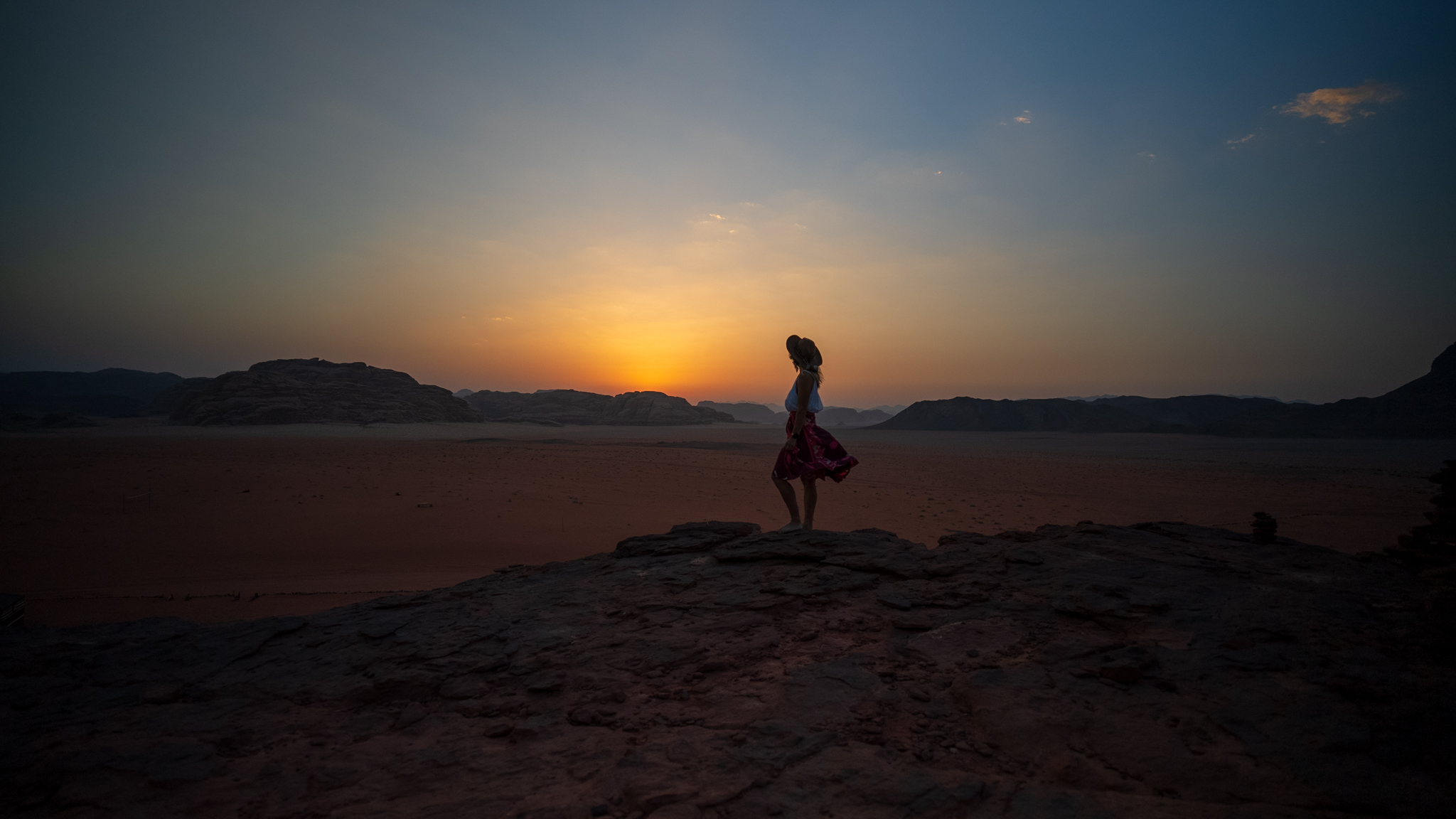
Two Weeks in Jordan
Visiting Jordan really opened my eyes about travel in the Middle East. Since Jordan does not have oil, tourism is its main commodity, and the country is committed to promoting its ancient antiquities, culture, and history for future generations. Which means sustainability is hugely important. Visit Jordan is working hard to ensure travelers fly less by choosing to stay longer and see more of the country. Tourism initiatives are promoting companies that support local economies, preserve culture, history, and tradition, and also maintain standards in measuring and reducing carbon emissions, waste, and water reductions.
Needless to say, Jordan is a truly unique and unforgettable country – one that is a great destination for anyone in search of sustainable adventure travel.
SHARE, SAVE or COMMENT BELOW
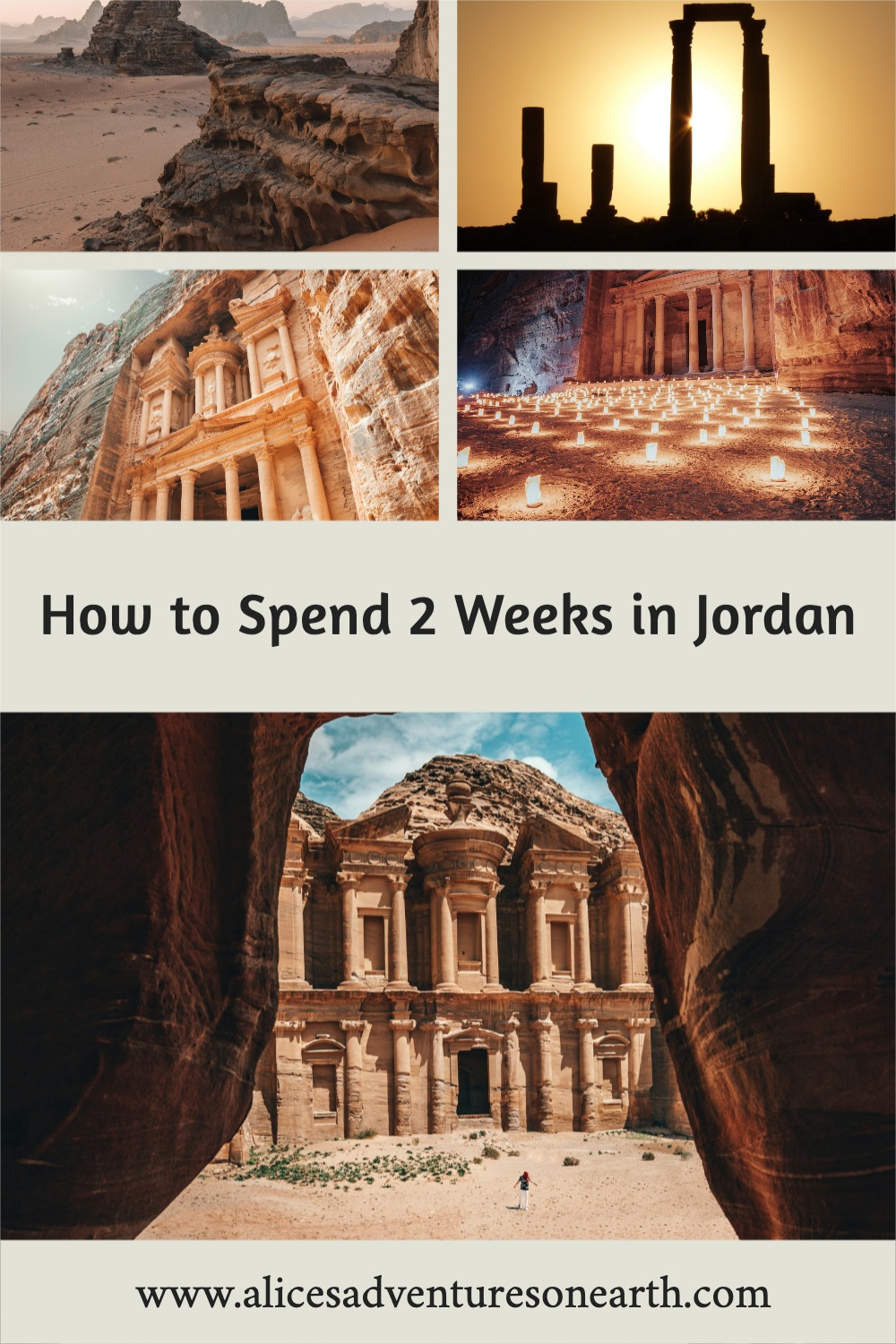






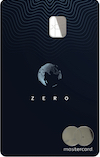

0 Comments